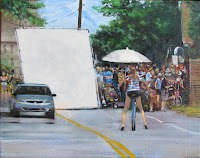 |
| Girl on Bicycle - Take Two |
The movie fun and excitment that began last summer in Green Harbor continues. I'm referring to the movie that was filmed on our street last summer. In a previous blog entry I described a painting I did depicting a long view of the street while a scene was being filmed. A young girl on a bike was queued up to ride away from me toward the house that was used as a primary set for the movie. That painting, "Girl on Bicycle - Take Two" was sold for me by the Jeanie Madsen Gallery in Santa Monica. That first painting is on the left and its description is in a blog post from last summer. (Search this blog for label "movie")
Even since the filming of the movie, The Way, Way Back was completed last August, we have been wondering if and when this independently-made movie would be released. We learned this week that the movie is slated to be part of the Sundance Film Festival at the end of this month (January 2013). Yaay! Here is the listing from the film festival program.
 |
| Stage One - Disappearing Lilies |
http://filmguide.sundance.org/film/13111/the_way_way_back
With this extra good news, I began another movie related painting. Photography had not been allowed during filming, but on the non-filming days, the neighbors were free to look around the set. I had taken a few pictures with the permission from the security detail.
 |
| Stage Two |
I recycled a subpar white lily painting, which provided a nice under-texture (see Stage One - Disappearing Lilies). In stage one of the painting, one lily is still plainly visible. The house that was used for filming was the backdrop of the painting. Two blue pop-up tents that the filming crew used to shelter the equipment and cast from the elements are shown. A large piece of lighting equipment was placed on the left in front of the barn. Two members of the cast/crew members were sitting under the tent, fully immersed in a discussion of the next scene. The question is who were they? And, were they rehearsing the next scene, or interpreting lines?
 |
| Stage Three |
As for the painting composition, I liked the geometric elements of the house (rooflines, windows, steps, movie equipment, etc) The weathered cedar shingles weren't difficult, but they were time consuming in that I applied several layers of semi-dry brush color on sequential days to get a rough, rustic look. The branches of the old cedars that were overhead soften the top of the house's roofline. I used my green oxide (a grayish green used for flesh shadows), mixed with some ivory black to get the right shade of green for this purpose.
The biggest challenge was painting the two figures under the tent. I created this behind the scenes picture from two unrelated photos and memory. I knew that if I was going to put the figures under the tent their flesh would be would be in deep shadow and the sunlit flesh colors in my mismatched photo would not be accurate. In the Stage Two photo above, the figures are too light. This is despite the fact that I brightly back-lit the figures, hoping they would be more distinguishable and dark (by contrast). In the final photo Bay Ave Back Lot, I did darken the figures, especially the man. Since the woman was fair I made a conscious decision to leave her a little brighter, as though she was getting more reflective light where she was sitting than the man.
I'm thinking this painting makes a nice remembrance of the summer of 2012 - the year that "The Way, Way Back" was filmed in Green Harbor, Massachusetts.
 |
| Bay Ave Back Lot |
















